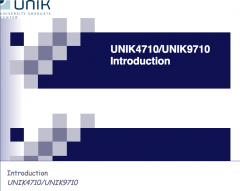Policies and Semantic Web Rules in Practise
From its-wiki.no
| Wiki for ITS | ||||||
|---|---|---|---|---|---|---|
|
Policies and Semantic Web Rules in Practise
| Course | UNIK4710, UNIK9710 |
|---|---|
| Title | Policies and Semantic Web Rules in Practise |
| Lecture date | 2015/04/17 |
| presented | by Josef.Noll |
| Objective | During this lecture we will discuss the important requirements in the semantic web services context, focusing on policies. |
| Learning outcomes | During this lecture you will have your own rules defined in your ontologies. You also know the difference between the outcome of a semantic rule and the outcome of a query:
|
| Pensum (read before) | |
| References (further info) | References:
|
| Keywords | policy languages, SWRL, Policies, Rules, Query |
this page was created by Special:FormEdit/Lecture, and can be edited by Special:FormEdit/Lecture/Policies and Semantic Web Rules in Practise.
Test yourself, answer these questions
- Try to understand the examples: See "References".
- Try to implement a counter: See "Adding amounts".
Lecture notes
Lecture notes 2014
Lecture notes 2013
Lecture notes 2012
Presentations
Presentations 2013
- Protege 3.x vs Protege 4.x by Martin - see presentation later down (run presentation from this page)
- SWRL in Protege 4.x by Philip: See http://goo.gl/xxxxx
- Properties & internal reasoning in Protege by Jose: Media:Properties_Jose.pdf
- Protege 3.x vs 4.x by Martin: Media:protege3_vs_4.pdf
Good presentation
Other Info
- Title
- Running an example: Rules for measures
- Author
- Josef Noll
- Footer
- Policies and Semantic Web Rules in Practise
- Subfooter
- UNIK4710/UNIK9710
⌘ Ontology
- Ontology - Protege: Media:Salary-Query_example-owl.zip
⌘ Rules for measures
- Have owl class called Salary with properties hasCurrency and hasAmount,
Person(?p) ^ hasMinSalary(?p, ?s) ^ hasAmount(?s, ?a) ^ swrlb:greaterThan(?a, 10000) -> query:select(?p)
- Creating a query to get information out of my ontology:
Person -> Instance: Arne -> hasMinSalary -> has value (15000)
Person(?x) ^ hasMinSalary(?x,?p) ^ hasAmount(?p,?a) ^ swrlb:greaterThan(?a,90) -> sqwrl:slect(?x,?a)
⌘ Example
Person(?p) ^ hasAge(?p, ?age) ^ swrlb:greaterThan(?age, 17) -> Adult(?p)
Can be easily turned in to a SQWRL query by replacing its consequent:
Person(?p) ^ hasAge(?p, ?age) ^ swrlb:greaterThan(?age, 17) -> sqwrl:select(?p, ?age)
Another alternative is to simply add a sqwrl:select clause at the end of a rule:
Person(?p) ^ hasAge(?p, ?age) ^ swrlb:greaterThan(?age, 17) -> Adult(?p) ^ sqwrl:select(?p, ?age)
⌘ Adding amounts
how do I formulate that
- Person listens to a song -> count+1 (of that person listening to the song)
- Info SWRLBuiltInBridge: http://protege.cim3.net/cgi-bin/wiki.pl?SWRLBuiltInBridge#nid88T
⌘ Protége 3.x versus 4.x
by Martin
Two different modeling paradimgs:
- Protege 3.x using OWL 1.0
- Protege 4.x using Frames
What we want to use depends on the need of our ontology
⌘ Similarities
Same structure:
- Classes (collection of instances)
- Properties (describes attributes of classes and relationships)
- Individuals
The difference lies within the semantics….
⌘ Differences
OWL 1.0 (Protege 3.x)
- Objects with same name can be the same thing
- Open World Assumption (everything is ALLOWED until otherwise specified)
- Can contain instances of all kinds of interpretations
- Statements about classes can be both must and necessary
- Different reasoner
- SWRL Query language
Frames, OWL 2.0 (Protege 4.x)
- Objects with same name are assumed to be different
- Closed World Assumption (everything is PROHIBITED unitil otherwise specified)
- Can only contain instances which are explicitly specified
- Statements about classes goes for all children (only must)
- Logical query language
- More property characteristics
⌘ Strengths of OWL 1.0/Protége 3.x
- Allowing inferred subclasses and type information
- Reducing number of facts we need to know before making complex expression (more freedom)
- Apply standard set of operations on classes
- Transitive properties
⌘ Strenghts of OWL 2.0/Protége 4.x
- Supports metamodeling
- Classes may be used as property values
- Default reasoning (defaults are used to fill partial knowledge)
- User defined data types
